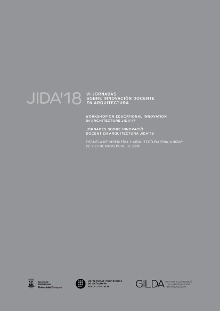Teaching innovation through Information and Communication Technologies
DOI:
https://doi.org/10.5821/jida.2018.5496Abstract
At present we observe how the Information and Communication Technologies (ICT) constitute pedagogical tools of great interest. These configure a new paradigm that imposes changes in the way of conceiving the teaching-learning process based on the use of technology in favor of teaching. The present article aims to show the development of an innovative teaching experience in the area of Architectural Projects through the use of the blog and social networks. The results obtained show how the use of ICT in the teaching of the architectural project encourages student creativity, streamlines and makes more interactive the teacher-student and student-student relationship, encourages training outside the classical classroom, increases autonomy in the student, it encourages a greater involvement of the students in their training and favors their personal motivation, their capacity for reflection and analysis and, therefore, their ability to learn.
References
ADELL, J. (2010). Congreso Modelos de Integración de las TIC en Educación. <http://www.ite.educacion.es/congreso/modelostic/index.php?Itemid=7&catid=4%3Aponentes&id=95%3Ajordi-adell-lang=es&option=com_content&view=article> [Consulta 14/08/2018].
ALEMANY MARTINEZ, C. (2009). “Redes sociales: una nueva via para el aprendizaje†en Cuadernos de Educacion y desarrollo, vol. I, no. 1.
<http://www.eumed.net/rev/ced/01/cam4.htm> [Consulta: 14/06/2018].
COLLAZOS, C., GUERRERO, L., VERGARA, A. (2001). Aprendizaje colaborativo: un cambio en el rol del profesor. Memorias del III Congreso de Educacion Superior en Computacion, Jornadas Chilenas de la Computacion.
<http://www.dcc.uchile.cl/~luguerre/papers/CESC-01.pdf> [Consulta: 22/07/2018]
DE HARO, J. J. (2010). Los principios de una educación 2.0.
<http://jjdeharo.blogspot.com/2010/02/herramientas-para-una-educacion-0.html> [Consulta: 23/07/2017]
DE HARO, J. J. (2010). Redes sociales para la educación. Madrid: Anaya Multimedia.
FERDIG, R. ( 2007). “Examining social software in teacher education†en Journal of Technology and Teacher Education, no. 15 (1), p. 5-10.
HERNÃNDEZ REQUENA, S. (2008). “El modelo constructivista con las nuevas tecnologÃas: aplicado en el proceso de aprendizajes†en Revista de Universidad y Sociedad del Conocimiento, vol. 5, no. 2, p. 26-35.
LÓPEZ MENESES, E. (2009). Innovar con blog en las aulas universitarias. Revista DIM: Didáctica, Innovación y Multimedia, no. 14.
<http://bit.ly/uWwRli> [Consulta: 22/07/2017]
LOZANO, J. M. (2008). “La Web 2.0. Avances en Supervisión Educativa†en Revista de la Asociación de Inspectores de Educación en España, 8.
LOZANO, R. (2011). Las TIC/TAC: de las tecnologÃas de la información y comunicación a las tecnologÃas del aprendizaje y del conocimiento.
http://bit.ly/ijF8mQ [Consulta: 23/07/2017]
MALONEY, E. J. (2007). “What Web 2.0 can teach us about learning†en Chronicle of Higher Education, 53 (18), B26.
PORRUA G., M. (2009). El impacto de las redes sociales. Tecnologia y gestion. Revista Dintel, no. 4. <http://www.revistadintel.es/Revista/Numeros/Numero4/TyG/porrua.pdf> [Consulta 22/07/2018].
VIVANCOS, J. (2011). Aproximación a la competencia digital docente.
<http://ticotac.blogspot.com/> [Consulta 22/07/2018].



















